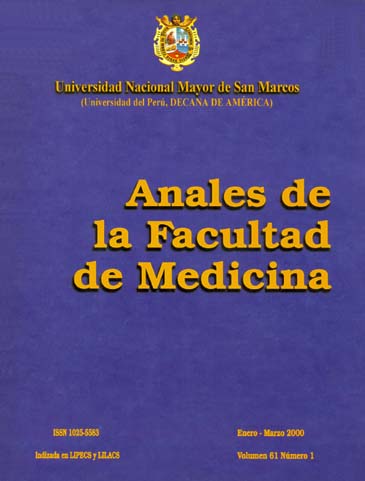Características Clínico-Epidemiológicas de la Oftalmopatía de Graves: Significado Etiopatogénico
DOI:
https://doi.org/10.15381/anales.v61i1.4247Palabras clave:
Oftalmopatía, Enfermedad de Graves, ExoftalmiaResumen
OBJETIVO: Determinar si las características clínico-epidemiológicas y de laboratorio que presentan a su ingreso los pacientes hipertiroideos por Enfermedad de Graves, influyen en la ocurrencia de la oftalmopatía de Graves (OG). MATERIALES Y MÉTODOS: Estudio analítico, observacional, de corte transversal de 97 pacientes hipertiroideos, 69 cumplieron los parámetros del protocolo. RESULTADOS: La OG es más frecuente en mujeres en proporción de 1, 1: 1 y en la 51 década de la vida, aunque ninguno de estos factores mostró significancia. El inicio paralelo, dentro de los 6 primeros meses de manifestaciones sistémicas, sí es estadísticamente significativo. El tabaco demostró significancia estadística en el desarrollo de OG. Los grados severos son más frecuentes en varones. El exoftalmos está presente en 27% de pacientes y predominan los signos clínicos dependientes de partes blandas. CONCLUSIONES: Los primeros 6 meses de iniciadas las manifestaciones sistémicas y el antecedente de tabaquismo deben constituir motivo de alerta para detectar la aparición de OG. El exoftalmos es detectado en un tercio de pacientes, siendo la Exoftalmometría de Haertel un método 100% específico para su determinación. El dosaje sérico de Ig no es útil en la valoración del paciente en riesgo.Descargas
Publicado
2000-03-13
Número
Sección
Trabajos originales
Licencia
Derechos de autor 2000 Elizabeth Garrido

Esta obra está bajo una licencia internacional Creative Commons Atribución-NoComercial-CompartirIgual 4.0.
Aquellos autores/as que tengan publicaciones con esta revista, aceptan los términos siguientes:
- Los autores/as conservarán sus derechos de autor y garantizarán a la revista el derecho de primera publicación de su obra, el cuál estará simultáneamente sujeto a la Licencia de reconocimiento de Creative Commons que permite a terceros compartir la obra siempre que se indique su autor y su primera publicación esta revista.
- Los autores/as podrán adoptar otros acuerdos de licencia no exclusiva de distribución de la versión de la obra publicada (p. ej.: depositarla en un archivo telemático institucional o publicarla en un volumen monográfico) siempre que se indique la publicación inicial en esta revista.
- Se permite y recomienda a los autores/as difundir su obra a través de Internet (p. ej.: en archivos telemáticos institucionales o en su página web) antes y durante el proceso de envío, lo cual puede producir intercambios interesantes y aumentar las citas de la obra publicada. (Véase El efecto del acceso abierto).
Cómo citar
1.
Garrido E. Características Clínico-Epidemiológicas de la Oftalmopatía de Graves: Significado Etiopatogénico. An Fac med [Internet]. 2000 Mar. 13 [cited 2025 Jun. 6];61(1):21-30. Available from: https://revistasinvestigacion.unmsm.edu.pe/index.php/anales/article/view/4247



